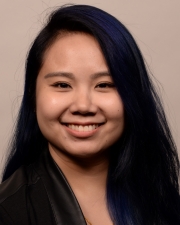Increasing the visibility of Southeast Asian students: A discussion with Linda Pheng
A common refrain among Asian American students in educational environments is that they feel unseen, unheard and disregarded. Across the country, and here in Philadelphia, Asian American students say they are rendered invisible and left out of the conversation. Linda Pheng, an assistant professor who teaches in the Education, Culture, and Society master’s and doctoral programs at Penn GSE, is committed to studying and abating this phenomenon.
Pheng herself is the daughter of Cambodian refugees, which she says colors her work and her understanding of academic erasure. Her research suggests that Southeast Asian students are often faced with a gantlet of specific difficulties. Asian American students are not just dismissed because of their relative academic achievement, but they also face larger cultural invisibility. When the specific experiences of Southeast Asians are discussed in class, she says, there is no real exploration of the depth of their cultural contributions – instead, they are mentioned only as a touchstone for understanding historical events. For example, says Pheng, students often learn about conflicts that may involve Southeast Asians but not about their cultures or experiences as people.
“They may study the Vietnam War, but they never study Southeast Asian people themselves.”
The superficial nature of materials related to the Southeast Asian experience, says Pheng, contributes to the erasure and invisibility of students. “You might have a memoir about the Khmer Rouge as outside reading,” she says, “but that’s just extra to the official curriculum.”
Pheng also finds that, while diversity as a concept is often celebrated in schools, Asian and Asian American students, in spite of the vast cultural and ethnic differences among them, are often lumped together as one amorphous societal entity. “In this way, you only have to think of students of Asian descent as one monolithic group,” says Pheng. “And you can treat them all the same way.”
Much of Pheng’s work centers on bringing critical qualitative research to a field of study where such work is scant, often for the same reasons that students of Southeast Asian descent are left out of lower-grade educational conversations. This, she says, is part of what brought her to Penn and, more specifically, to Penn GSE’s Education, Culture, and Society Program.
“What attracted me to this program was the broad understanding of foundations of education, namely what education can look like, and also the prioritizing of the interdisciplinary nature of analysis,” she says.
While Pheng is relatively new to Philadelphia – she completed her bachelor’s and master’s degrees at the University of Maryland and completed her doctorate at the University of Wisconsin-Madison – much of her recent work has been focused in and around South Philadelphia, where there is an exceptionally high concentration of Southeast Asian – but particularly Cambodian, Vietnamese and Laotian – students. She says that cultural differences in urban school districts, as well as a scramble for scant resources, have made it difficult for Southeast Asian students to gain visibility and accord with other student populations.
A substantial portion of Pheng’s research is also focused on cross-racial organizing and coordination for Asian Americans in community-based spaces. She explores these ideas in an Educational Studies article she co-authored that received the 2023 AESA Taylor & Francis Educational Studies Award for the Best Paper of the Year. Her contention is that spaces have to be carved out in order to foster greater dialogue, interaction and understanding across groups. “The first step,” she says, “is to understand who you are. And then, understand that solidarity means showing up and being present for one another’s causes.”
Pheng describes the Southeast Asian school experience as something akin to a “refugee camp.” Not in a literal sense, of course, but in the sense that refugee camps are where people of similar backgrounds find themselves together because of external conditions beyond their control. In some ways, she says, this can be positive or negative.
“Refugee camps are places where you can learn skills to survive,” says Pheng, “but they are also sites of containment that are temporary and transitional. Ultimately, schools should be sites of community and not containment for all young people.”
Pheng is sure to note something important about the Southeast Asian academic experience: not only are Southeast Asian students not well represented in academic environments and literature, but their experience is critically understudied, often for the same reasons that they are overlooked in school. The model minority myth, in which “Asians” writ large are regarded as the foremost academic achievers, she says, allows scholars and policymakers to both overlook and disregard these students’ place and holistic well-being in schools and academic settings.
Ending erasure and invisibility, according to Pheng, will require a lot of work. Her recommendations to increase visibility for Asian and Southeast Asian students are twofold.
First, she recommends that statistics on Asian and Southeast Asian students be disaggregated, meaning that data should reflect the vast cultural and economic differences between different ethnicities and subcultures within the “Asian” identity marker.
Second, she says, schools should create spaces for activism from students of Asian descent. She highlights the work of local organizations such as Viet Lead, the Cambodian Association of Greater Philadelphia, Asian Americans United and the Southeast Asian Mutual Assistance Association Coalition as resources for engaging Asian and Asian American students for positive social change.

